Research Achievement
2016
전하밀도파현상은 저차원전자계의 핵심적인 물성의 하나로 금속전자계가 전자-격자상호작을 통하여 다체적인 절연상태로 전이하는 현상이다. 특히 전하밀도파현상과 전자-전자 상호작용과 같은 서로 다른 상호작용의 경쟁을 통해 고온초전도체와 같은 새로운 물리현상이 발현된다고 생각되고 있으며, 전하밀도파의 불순물 등에 의한 붕괴는 초전도현상 등으로 이어질 수 있다. 본 연구진은 이러한 현상을 일으키는 대표적인 물질계로서 TaS2의 전하밀도파상에 집중하고 있다. 이 물질의 경우에는 단순한 전하밀도 파계를 넘어서 전자-전자 상호작용을 통해 전하밀도파가 형성된 금속상에서 모트절연체상으로 전이하는 기저상태를 가진다. 이러한 모트-전하밀도파 절연체에 여러 가지 자극, 압력, 도핑 등을 가하게되면 전하밀도파 질서가 부분적으로 붕괴된 비정합전하밀도파상이 발생하고 이 상으로부터 초전도가 발현된다. 본 연구에서는 이 비정합전하밀도파상을 주사터널현미경 탐침에서의 전압펄스 인가를 통해 국소적으로 유도할 수 있는 기법을 고안하였다. 또한이렇게 형성된 비정합전하밀도파상의 전자구조를 원자단위로 측정하는데 성공하였다. 이 측정결과를 이론과 비교하여 분석한 결과, 도메인월이 형성된 비정합전하밀도파상, 이 전자-전자 상호작용이 강한 상태에서 발현되는 특이한 금속상이라는 것을 밝힐수 있었다. 이 연구결과는 비정합전하밀도파상에서 발현되는 초전도현상을 이해하는데 핵심적인 정보를 제공하고 있다. 아울러, 모트-전하밀도파절연체와 비정합전하밀도파 금속상 사이의 상전이가 초고속에서 일어남이 최근 알려져, 본 연구에서 발견한 국소적인 비정합전하밀도파상의 제작방법은 나노스케일에서 초고속으로 스위칭소자로 발전할 가능성을 내포하고 있다.
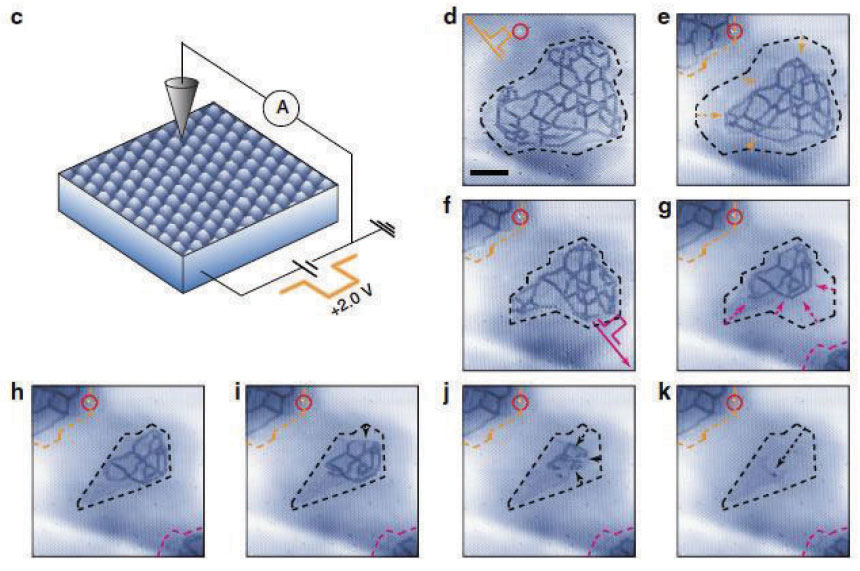
Figure 1. STM topographies of 1T-TaS2 after injecting strong tunneling current pulse from STM tips
The control and manipulation over correlated electronic states of solids have been challenging but provide exciting opportunity to develop novel electronic devices. For example, the metal-insulator transition of a Mott insulating state can lead to a new type of non-volatile memory devices. As one of the most exciting candidate in this direction, very recently, the Mott insulating state of a layered transition metal dichalcogenide of 1T-TaS2 was shown to be switchable in a ultrafast time-scale with optical laser pulses, paving an avenue to ultrafast non-volatile memory devices based on correlated electrons. However, the electronic switching for realistic devices has been challenging and the unusual nature of the metallic state attracted attention. In this work, we provide two important breakthroughs in this field. We demonstrate the Mott phase of this material can be manipulated electronically in nanoscale, switched into nanoscale metallic patches reversibly. We believe this is the first clear demonstration of the reversible nanoscale manipulation of the Mott transition. This work provides an essential step stone to nanoscale ultrafast memory devices based on correlated electrons. Moreover, we clarify the microscopic mechanism of this transition, which is related to the beautiful and unique physics; the strong intercoupling of the Mott state with a distinct order of the charge density wave. The present spectroscopy work with unprecedented spatial resolution clarifies that the metallic state emerging is another novel correlated electronic state near the Mott criticality as controlled by the degree of the charge order coherence. The present work substantially deepens our understanding of complex correlated electronic states coupled with other types of orders, which lead to new emerging physics and in turn provide extra controllability over those strange electrons.
전하밀도파현상은 저차원전자계의 핵심적인 물성의 하나로 금속전자계가 전자-격자상호작을 통하여 다체적인 절연상태로 전이하는 현상이다. 이 현상은 일차원계에서 가장 잘 발현되며, 다양한 이차원전자계에서도 발견된다. 특히 전하밀도파현상과 전자-전자 상호작용과 같은 서로 다른 상호작용의 경쟁을 통해 고온초전도체와 같은 새로운 물리현상이 발현된다고 생각되고 있으며, 전하밀도파의 불순물 등에 의한 붕괴는 초전도현상 등으로 이어질 수 있다. 본 연구진은 일차원과 이차원 전자계에서 전하밀도파를 결함과 도핑 등을 통해 붕괴시키면서 발생하는 다양한 미시적인 여기(들뜸)들과 이로부터 발현할 수 있는 새로운 물리현상에 주목하여 중장기적인 연구를 진행하고 있다. 본 연구에서는 일차원 전하밀도파계의 대표적인 물질계인 인듐원자선계에 불순물인 산소원자를 인위적으로 도입하여 전하밀도파와 불순물의 상호작용을 전하밀도파 상전이 온도 부근에서 원자분해능으로 관찰하였다. 그 결과 상전이 온도보다 높은 온도영역에서 국소적인 전하밀도파가 불순물들에 의해 생성됨을 확인하였다. 더 나아가 생성된 국소 전하밀도파와 불순물원자들의 관계를 정량적으로, 이론적으로 분석하여, 이러한 고온 국소전하밀도파가 두 개의 불순물원자들과 격자의 결맞는 상호작용에 의해 일어남을 밝힐 수 있었다. 즉, 불순물원자들이 집단적으로 전자-격자상호작용의 세기를 조절하게 된다는 새로운 물리현상을 발견하였다. 이러한 집단적이고 협동적인 불순물의 작용은 다양한 전하밀도파계에 응용될 수 있으며, 전자•격자상호작용이 중요시되는 초전도체 등의 연구에도 폭넓게 적용될 수 있을 것으로 사료된다. 아울러 본 연구에서 발견된 국소적인 전하밀도파는 원자단위에서 발생하는 금속-절연체접합으로서 이를 응용한 전자수송과 소자의 기초연구에 활용될 가능성이 있다.
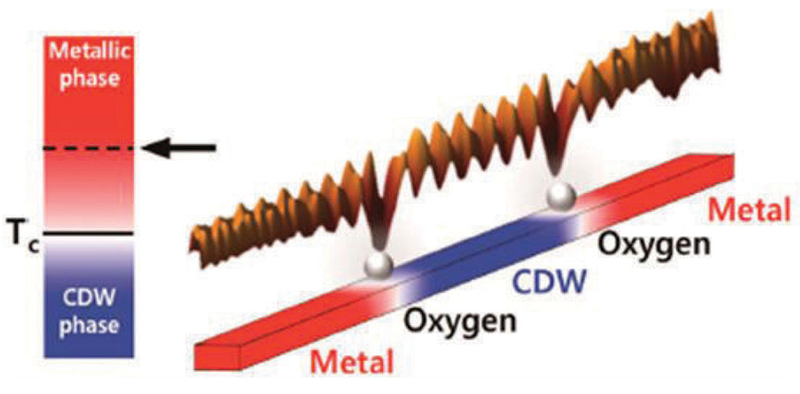
Figure 2. STM topography and its schematics for a In atomic wire segment where the CDW state is locally condensed between two oxygen impurities
While impurity has been known widely to affect phase transitions, the atomistic mechanisms have rarely been disclosed due to various difficulties such as the lack of atomic scale resolution in microscopy, the limited accessibility to the transition temperature, the dynamical nature of the phase transition, and the ill characterized impurities themselves. For condensed matters, the most important interaction of the impurity with the phase transitions involves those with the phase transitions of electronic orders such as the charge density wave and superconductivity. In this work, we succeeded in directly observe the atomistic details of the condensation of a charge density wave electronic order mediated by atomic scale impurities, through a few experimental breakthroughs to overcome those traditional difficulties. Not only showing directly the classical physics in atomic scale, we revealed unexpectedly that atomic scale impurities cooperate to induce the condensation, which even increases the transition temperature substantially. In this particular case, the cooperation is through the lattice strain field of the impurities emphasizing the electron-lattice interaction nature of the charge density wave phenomena. This introduces a new and generalizable concept of impurity cooperation in phase transitions, which can be widely applied and considered.
강한 상호 작용을 하는 이차원 전자계는 학문적 연구와 상업적 발전에 기대 및 이바지 한 바가 매우 커 오랜 시간 연구가 되어 왔다. 새로운 소자 개발 및 물리학계에 던지는 화두가 큰 물질은 그래핀을 시작으로 하여 현재는 전이 금속다이칼코지나이드 (Transition Metal Dichalcogenides : TMD) 로 발전 하게 되었고, 이리듐 다이 텔루라이드(IrTe2)는 TMD 중에서도 스핀-궤도 결합 이 강한 물질로, 소위 복잡계 시스템을 구축하는 데에서 그 의미를 가지며, 이로 인해 생기는 상전이 및 도핑에 의한 초전도 현상은 물리학계의 주목을 받아 왔다. 본 연구에서는 기존에 알려진 상전이 이후의 선형의 상 (Stripe Phase) 이외에 육각구조를 가지는 새로운 상(Hexagonal Phase) 이 존재함을 보였고, 이는 전하 정렬의 결과 (Charge Ordering)에 따른 상전이의 결과임을 밝혔다. 또한 이 새로운 상에서 나타나는 초전도는 기존에 학계에 보고된 도핑에 따른 초전도와 무관하게 독립적으로 존재하며, 이는 각 층이 개개의 층으로 나누어진 층상 물질인 IrTe2의 표면층과 그 아래층 사이의 층간 상호작용이 약해짐에서 기인하는 것임을 밝혔다.
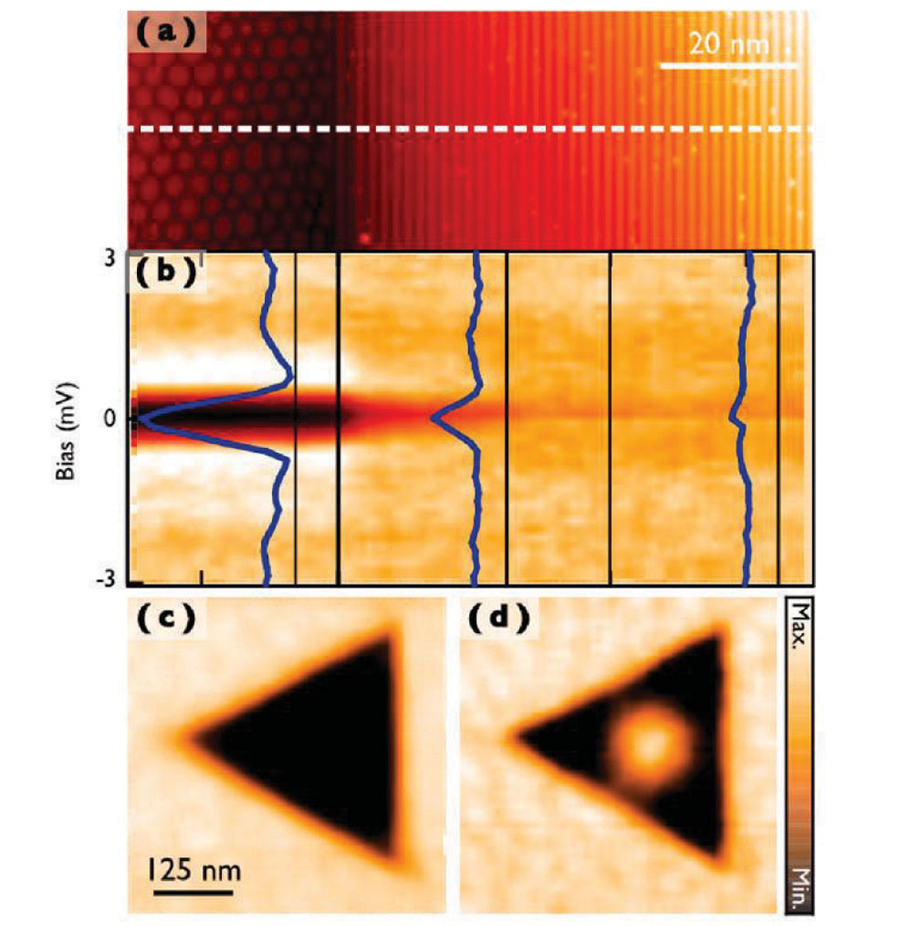
Figure 3. (a) STM images of stripe and hexagonal phases coexisting on IrTe2. (b) STS spectral map for the superconducting gap variation across the phase boundary. (c) Superconducting vortex within an isolated hexagonal domain as imaged by STS dI/dV map at the Fermi level
The unconventional superconductivity of ‘simple’ two dimensional transition metal dichalogenides(TMD) is attracting current interest (Nature Physics News and Views February 2016) for elucidating new physics in addition to their potential as novel device platforms. Adding up extra interactions into such superconductivity, such as spin-orbit interactions and electron correlation, can possibly bring us into a new and unexplored regime of physics. One strong candidate TMD materials for the combination of strong interactions and 2D superconductivity is IrTe2 due to its strong charge order interaction, strong spin-orbit interaction, and emerging superconductivity after doping, as covered by series of recent papers. While the understanding of this‘complex’TMD superconductivity is not established yet, we showed in this work that the superconductivity is closely related to an unprecedented type of charge ordering, the honeycomb charge order. This work indicates that this ‘complex’superconductivity has parallel with the pnictide superconductivity with nematic orders and the cuprate superconductivity with CDW orders. We believe that this work shows a new direction for the quest of new physics of TMD materials, putting extra interactions and complexity, and connects th TMD physics with those of more traditional uncon entional superconductivity physics.
연구단에서는 일차원 이차원물질계에서의 상호작용에 의해 발생하는 새로운 물리현상과 이러한 물리현상의 발현을 가능하게하는 플랫폼으로서의 새로운 저차원계 물질을 탐색하는 연구를 중점적으로 수행하고 있다. 기존에 저차원전자계에서 주목되어온 상호작용은 대표적으로 전자-전자상호작용과 전자-격자상호작용이다. 특히 후자의 경우는 전하밀도파와 초전도와 같은 핵심적인 기본물성을 야기하여, 오랫동안 연구가 되어왔다. 이러한 잘 알려진 전하-격자상호작용의 경우도 물질이 단원자층 단원자선 등 극한적인 차원의 물질계가 되었을 때 어떠한 변화를 거치며 새로운 물성의 발현으로 이어질 것인가가 최근의 관심사중의 하나이다. 특히 단원자층 물질계와 이차원전자계의 프로토타입물질이라 할 그래핀에서의 전자-격자상호작용은 그간 많이 연구되어왔다. 전자-격자상호작용은 다양한 방법으로 측정이 가능한데, 특히 각분해광전자분광 스펙트럼에서는 전자밴드분산의 꺽어짐 특이구조(kink structure)로 나타난다. 그런데, 최근의 실험에서 격자운동과 관계없는 에너지 스케일인 ~4 eV 의 큰 에너지에서 그래핀의 전자밴드분산 스펙트럼상의 꺽어짐 특이구조가 관측되어 그 해석에 곤란을 겪어왔다. 본 연구에서는 이 결과를 좀 더 상세히 재측정하여, 해당 특이구조가 두 개의 분리된 전자밴드들 사이에서 광전자분광 스펙트럼의 세기가 점진적을 변화하면서 나타난다는 사실을 밝힐 수 있었다. 이는 전자-격자상호작용과 관계가 없는 현상으로서 최근 제기된 의문에 명확한 물리적인 해답을 제시한다 할 수 있다.
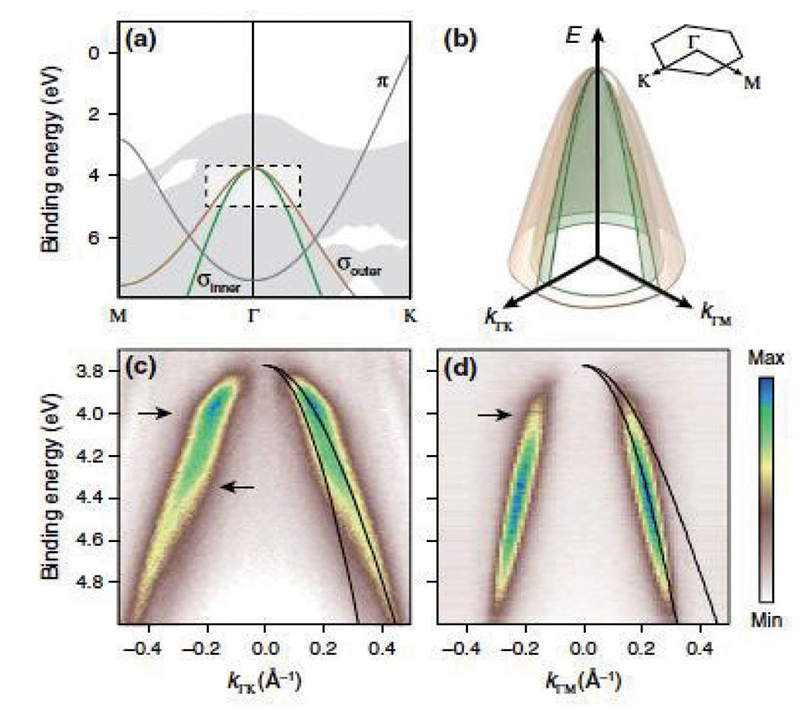
Figure 4. Calculated and measured band dispersions of sigma bands of epitaxial graphene. Measured data show strange kink-like structure between two branch bands
Kinks near the Fermi level observed in angleresolved photoemission spectroscopy (ARPES) have been widely accepted to represent electronic coupling to collective excitations in a low energy scale, but several different kinks observed at higher energies in a few different materials have eluded a unified description. In particular, such a high energy kind feature was observed in σbands of graphene recently with an anomalous energy scale as high as ~ 4 eV. In this work, we identify the mechanism leading to the σ band kink feature by means of ARPES and tightbinding band calculations. We found that two σbands show a strong intensity modulation with abruptly vanishing intensity near the kink features, which is due to sublattice interference. The interference-induced local singularity in the matrix element is a critical factor that gives rise to apparent kink features, as confirmed by our spectral simulations without involving any coupling to collective excitations.
통상적으로 밴드갭 구조를 가지는 반도체에서의 광학적 여기는 밴드간의 여기에 해당하는 1s 엑시톤 준위와 전도대 내의 여러 개의 고에너지 엑시톤 준위를 통하여 이루어지는데, 원자층 반도체에서의 이러한 현상은 아직 충분히 규명되어있지 않다. 본 연구에서는 펨토초레이저를 이용한 초고속 광학적 분광법을 이용하여 단일 원자층 반도체인 MoS2에서 수 ps 동안만 보여지는 전도대 내의 intraexcitonic transition (2p, 3p 등)을 최초로 보고하였다. 본 연구는 기존의 광학적 방식으로 측정이 불가능한 새로운 광전이 양상을 mid-infrared spectroscopy를 통해 확인하였고 이로써 단일 원자층 반도체의 엑시톤 거동에 대한 이해를 넓혔다는데 의의가 있다. 특히 이 연구를 통해 그래핀에 비하여 수십배의 광흡수율을 보이지만 다소 낮은 광변환 효율을 나타내는 MoS2와 같은 2차원 전이금속-칼코겐 화합물에서의 엑시톤 해리에 필요한 최소 에너지값을 제시함으로써, 고효율 광에너지 변환 가구에 대한 새로운 원리를 밝혀냈다.
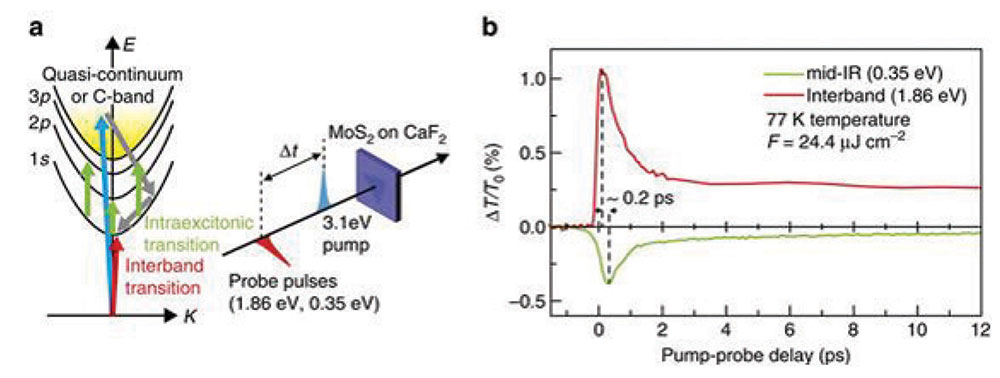
Figure 5. Ultrafast intraexcitonic and band-to-band spectroscopy in monolayer MoS2. (a) Schematic illustration of the ultrafast intraexcitonic (green) and conventional band-to-band (red) interband spectroscopy. (b) Transient dynamics of ∆Τ/Τ0 measured at two representative energies of 1.86eV (red) and 0.35eV (green)
We report the experimental observation of the 1s intraexcitonic transition in monolayer MoS2, reporting the presence of strong absorption in a 2D transition metal dichalcogenides (TMDC), whose fundamental optical absorption originates from the 1s ground exciton. Our ultrafast mid-IR measurements reveal twofold 1s 3p transition energies to be 0.27eV and 0.31 eV for A and B exciton, respectively. We additionally uncover an intraexcitonic relaxation channel of 1s 2p to be 0.36eV between 1s A and 2p B exciton. The large exciton-binding energy due to the non-local dielectric screening ensures not only 1s 2p transition to be observable, but also a higher-order transition of 1s 3p in a monolayer 2D TMDC at an elevated temperature, which cannot be accessible using conventional interband spectroscopy.
열전 효과(thermoelectric effect)는 물질 내의 온도 구배에 기인하는 전위차를 통해 전류를 발생시키는 열-전기에너지 변환 현상을 의미한다. 열전 효과의 효율을 판단하는 척도는 물질의 전기전도도와 열전도도로 표현되는 '열전 성능지수'(ZT, figure of merit)로 결정되며, 고효율의 열전 물질 연구의 핵심은 단일 물에서 최대 전기전도와 최소 열전도를 독립적으로 확보하는 기구를 파악하는 데에 있다. 그러나 일반적으로 물질의 열/전기전도도는 비례관계를 가지며, 따라서 동시에 증가 또는 감소한다. 본 연구에서는 화학기상증착법에 의해 합성한 이차원 황화주석(SnS2)에서 원자층 두께 변화에 따라 전기전도도와 열전도가 상이하게 변화함을 국소 광전류/열전도도 계측을 통하여 발견하였다.
특히 수 원자층 수준의 SnS2에서 두께가 감소함에 따라 열전도도가 감소되며 전기전도도는 오히려 증가하는 현상을 관찰하였으며, 따라서 상온에서 기존 벌크 재료 (ZT~0.0001)에 비해 1천배 가까이 향상된 열-전기 에너지 변환 효과 (ZT~0.13)를 나타냄을 보고하였다. 이러한 연구는 본 연구단의 핵심 연구 주제의 하나인 원자층 물질에서의 에너지 변환에 대한 물질 전형을 발견했다는 데 의의가 있고, 후속 연구를 통해 이의 미시적 기구 규명이 이루어 질 것으로 기대된다. 또한 이러한 연구는 이차원 물질계를 기반으로 하는 열전 변환 소자의 최대 변환 효율 확보에 대한 근본적인 근거를 제시할 것으로 기대된다.
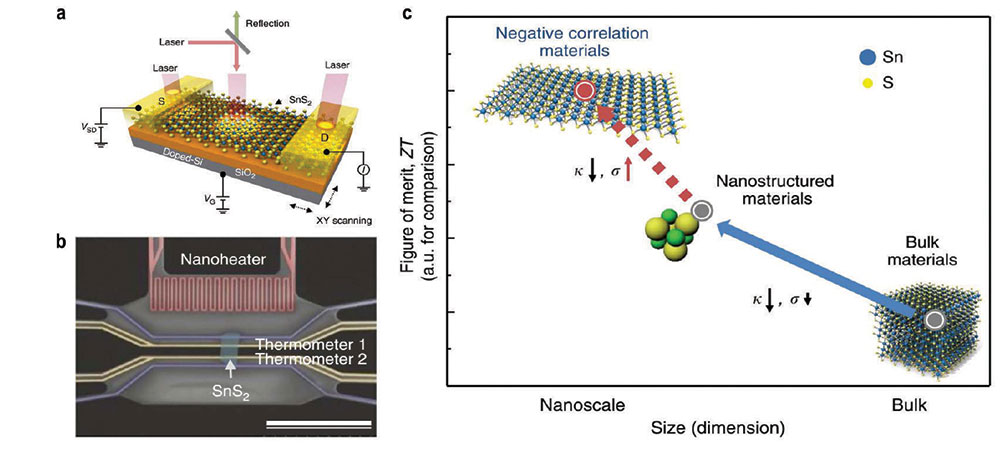
Figure 6. Pathwway and progress for high ZT in thermoelectric materials by negatively correlated electrical and thermal conductivity. (a) Thermoelectric current measurement of SnS2 laser scanning imaging. (b) Scanning electron microscopy image for thermal conductivity measurement. (c) Negatively correlated materials, which offer a method for increase of ZT. Solid blue arrow indicates previous progress, while the dotted red arrow is our proposed approach for further increase of ZT.
The electrical conductivity σand thermal conductivity ĸ can not be controlled independently in thermoelectric materials. We report that 2D nanosheet thermoelectric material, SnS2 demonstrates a negative correlation between electrical conductivity σand thermal conductivity ĸ. In other words, as the thickness of SnS2 decreases,ĸ increases whereas σdecreases, and thus thermoelectric figure of merit, ZT increases to 0.13 at room temperature, a factor ~1000 times greater than previously reported bulk single crystal SnS2. We believe a significant increases can be made for materials, which have negatively correlated electrical and thermal conductivity with a layered structure similar to SnS2, while having higher absolute electrical conductivity. Currently, researchers believe that materials with ZT of 0.5 at room temperature are useful for industrial applications. By investigating materials that have negative correlation between σand ĸ, we suggest that moderatetemperature thermoelectric materials can be discovered.
본 장비는 포항가속기연구소 저장링동 4A2 빔라인에 설치중인 스핀각도분해광전자분광 실험 장비로 다양한 시료의 에너지와 운동량을 측정하여 전자구조를 측정하고 추가적인 스핀 측정 장치를 함께 설치하여 전자의 스핀 정보도 함께 측정할 수 있도록 한다. 특히 최신의 전자 분석기는 3차원의 에너지와 운동량을 동시에 측정을 가능하게 하며 저 에너지 교환 산란 방식의 스핀 검출기는 기존의 모트 방식보다 20배 이상 효율이 뛰어나다. 2016년 시스템 자체의 오작동에 대한 수리와 실험시 문제가 발생할 수 있는 디자인적인 요소들에 대한 수정과 스핀 측정에 기본적인 실험 장치가 설치완료 되었으며 2017년 스핀 검출기 설치가 완료될 예정이다.
또한 시료 조정기 설치가 완료되었으며 상온과 액체헬륨온도에서의 장비테스트가 진행중이다. 시료 성장에는 원자선 증착 방식을 이용하고 시료의 구조 측정은 저에너지전자산란 방법과 오제전자분광법을 이용할 예정으로 각각 설치와 테스트가 완료되었다. 4A빔라인과 결합하여 유저들이 방사광을 이용한 실험을 진행할 수 있도록 할 뿐만 아니라 방사광 빔타임이 아닐 때에도 실험을 진행할 수 있도록 헬륨 자외선 발생 장치를 설치하였다. 본 장비가 완성되면 세계 최고 수준의 분해능을 갖춘 스핀과 전자밴드구조 측정을 가능케 하여 기존에 볼 수 없었던 저차원 전자계의 특성을 확인하여 물리학의 발전에 기여할 수 있을 것을 기대한다.
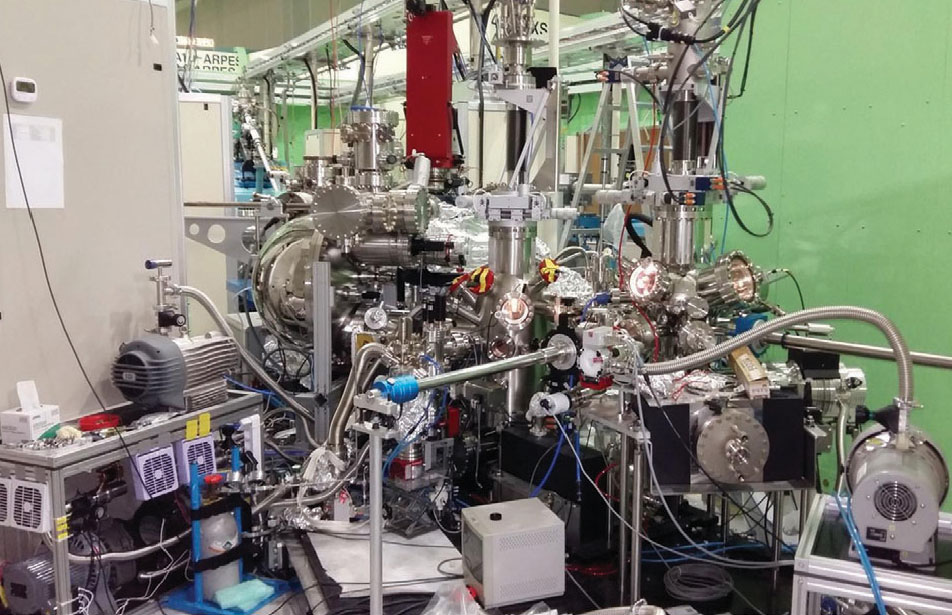
Figure 7. Spin-resolved ARPES end-station
Spin and angle-resolved photoelectron spectroscopy endstation is currently under construction at the undulator beamline 4A2 at the Pohang Light Source. This system will enable the users to directly investigate the electronic structures of various materials by detecting the energy, momentum, and spin of electrons within them. In particular, the state-ofthe-art electron analyzer simultaneously reveals the three dimensional space of energy and momenta in two direction, and the VLEED-type spin detector enhances the spin detection efficiency by orders of magnitudes compared to the conventional Mott-type spin detector.
Continuing from the previous year, some malfunctioning of hardwares and design problems have been fully repaired, and all the basic hardwares are installed for the parts for spin-integrated measurements and are currently being testing for operations. esides the synchrotron light source, which is to be connected soon, the high-intensity inhouse light source for ultraviolet radiation has been installed. This enables the offline measurement when the synchrotron light source is not available. As for the sample preparation systems, the molecular beam epitaxy (MBE) system has been installed. For the sample evaluation, the low-energy electron diffraction (LEED) as well as the Auger electron spectroscopy (AES) has been commissioned and are operational. In addition, the software for endstation monitoring and measurements are currently being implemented. The ARPES system will open for user in the first half of 2017 and the spin ARPES from the second half.
본 연구단의 극저온 고자장 주사 터널 현미경을 위한 희석식 냉동기는, 2016년 하반기에 제작이 완료되어 냉동기부품들이 2016년 12월 배송되었다. 2017년 4월에 제작사와 함께 냉동기의 재조립에 들어가, 2017년 하반기에는 각종 초고진공에서의 샘플 처리를 위한 각종 진공 펌프 및 진공 챔버의 조립 및 주사터널 현미경의 스캐너 헤드의 제작 및 그 설치 및 테스트를 수행할 예정이다.
본 장비는 100 밀리켈빈에서 600 마이크로와트의 강력한 냉각 파워를 보유하여, (1) 대략 10 밀리켈빈의 최종 기저 온도에 이를 수 있으며, (2) 샘플에 9+2+2 테슬라의 고자기장을 인가할 수 있고, (3) 48 시간 이상의 연속 측정이 가능함을 목표로 한다. 그림 8은 조립 직전 냉동기와 초전도 자석, 그리고 냉각 테스트 셋업의 모습이다. 냉동기의 냉각 테스트 결과 100 밀리 켈빈에서 600 마이크로와트를 확인하였다. 또한, 희석식 냉동기에서 오는 진동을 최소화하기 위해서 진공 방지 장치를 설치 중이다. 주사터널현미경의 스캐너 헤드는 Koala Drive 형태의 z방향 근접 접근 매커니즘을, 그리고 x, y 방향으로는 Besocke 형태의 매커니즘을 채택하여 사용할 계획이다. 스캐너 헤드의 원활한 조작을 위한 초고진공 내부에서 작동되는 내시경의 개발에 매진하고 있어, 2017년 후반기에는 장비 최종 완성을 목표로 하고 있다.
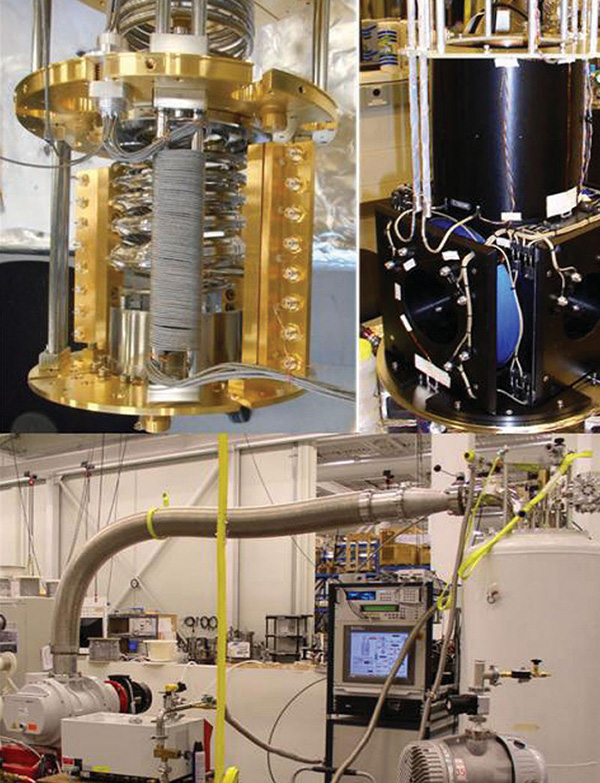
Figure 8. (Upper left) Dilution refrigerator, (Upper right) Superconducting magnet (Lower) Cryostat test setup
The dilution refrigeration cryostat for our ultralow temperature high magnetic field scanning tunneling microscope (ULT HF STM) has been constructed in late 2016 by the manufacturer, and the parts of cryostat have been delivered to Pohang in December 2016. In April 2017, we will start reassembling the cryostat, and in late 2017, we will attach a vacuum chamber, pumps, and STM scanner to the cryostat, and will test the overall performance of the ULT HF STM. Equipped with a strong cooling power of ~ 600 micro watt at 100 milli Kelvin, our STM can reach a sample base temperature of ~ 10 milli Kelvin, and can apply 9+2+2 Tesla to a sample. And the holding time of the cryostat is more than 48 hours. Fig. 8 shows our cryostat insert, superconducting magnet, and test setup. The test shows that the cooling power is ~ 600 micro watt at 100 milli Kelvin. And we are working on a vibration isolation mechanism against vibration coming from our dilution refrigerator cryostat.
For our STM scanner, we will use a modified Koala drive mechanism for tip z coarse approach, and a modified Besocke type mechanism for sample x, y motion. We are developing a scanner head manipulator using ultrahigh vacuum compatible endoscopes, and will finish the final assembling by late 2017.
샘플의 거시적 전기적 특성인 전기전도도와 국소적 전기적 특성인 상태 밀도 사이의 관계를 바로 측정 할 수 있는 주사터널현미경을 구축하였다. 현재 다양한 샘플을 이용한 실험이 진행 중이며, 이와 병행해서 전기 전도도 측정과 주사터널현미경 측정을 동시에 하기 위한 측정 시스템의 수정 및 보안 작업을 진행하고 있다.
수개월 내에 그래핀 디바이스에서 전기전도 측정과 주사터널현미경을 동시에 할 수 있어, 현재 그 가능성이 밝혀진 Veselago’s lens를 실공간 상에서 관찰하는 것이 가능할 것이라 기대한다. 그림 9의 왼쪽은 주사터널현미경을 초고진공 챔버에 설치 후의 모습이다. 그림 9의 중앙에 위치한 샘플홀더는 열전자를 가속하여 가열할 수 있는 장치이며, 이를 이용해 800도로 가열된 샘플 홀더의 모습도 있다. 이 가열 장치를 이용하여 깨끗한 표면을 얻을 수 있어, 그림 9의 오른쪽처럼 깨끗한 그래핀의 원자구조를 얻을 수 있었다. 그림 10은 설치된 냉동기와 주사터널현미경 헤드의 모습이며, 오른쪽 확대된 사진에서 샘플 스테이지에 4개의 추가 전극을 확인할 수 있다. 이 추가 전극으로 샘플의 전기전도도를 직접 측정할 수 있게 된다.
-

Figure 9. A scanning tunneling microscope with transport capability (left). A sample heating stage (middle). An STM image of graphene showing atomic lattices (right)
-
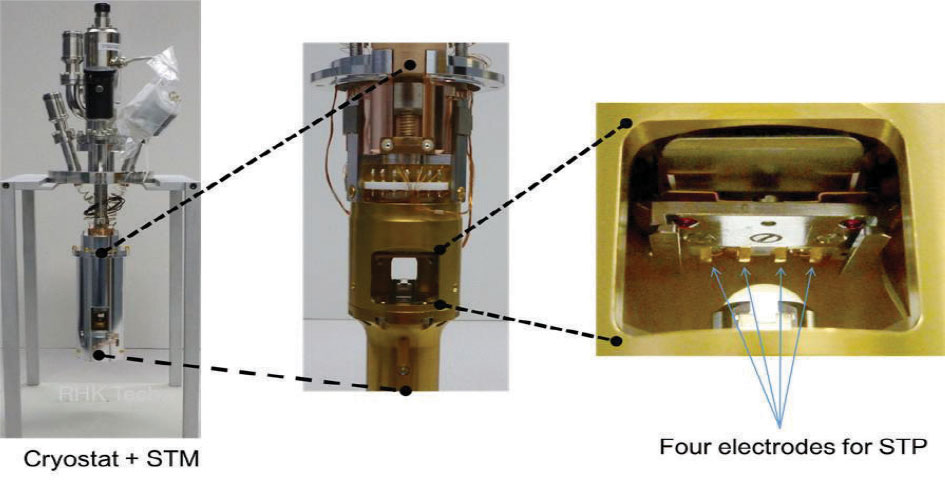
Figure 10. A STM head equipped with a continuous flow cryostat (left). A STM head without thermal shield (middle). A STM sample stage with additional four electric contacts for transport capability (right)
We built a variable-temperature scanning tunneling microscope (STM) which can measure local density of states by scanning tunneling spectroscopy (STS) as well as global electric conductivity by transport measurements. We have tried various samples while we have developed control electronics for efficient measurements.
Within months, we expect to visualize Veselago s lens in a real space by this variabletemperature STM with transport capability. The left image of Figure 9 shows a variable-temperature STM with transport capability. It has a sample heating stage, which can heat samples up to 1500 K in order to get clean surfaces. Due to this heating stage, we could get atomic images of graphene. Figure 10 shows a STM head equipped with a continuous flow cryostat, a STM head without thermal shields and a STM sample stage with additional four electric contacts for transport capability. This STM can be operated in a temperature range between 15 and 300K and be optimized in order to investigate temperature-induced physical phenomena such as temperature dependent phase transition. Furthermore, we can measure electric conductance through a whole sample to study transport properties. In addition, we use a load-lock system to introduce samples to our STM without breaking vacuum.
2016년 본 연구단에서는 광자 주사터널 현미경을 완성하였다(그림. 11). 이 광자 주사터널 현미경은 주사터널 현미경의 팁 샘플 터널 정션에서 방출되는 광자를 측정할 수 있다. 분광기와 CCD를 탑재하여, 터널 정션에서 광자의 에너지 분석이 가능하다. 주된 측정범위는 가시광선 영역대이다. 그림. 12에 보이는 것처럼, 초고진공 챔버안에 볼록 렌즈를 설치하여 그 초점에 STM팁 샘플 정션이 위치하게 하여 최대한 많은 광자를 포집하도록 하였다. 측정 가능한 온도 대역이 8 켈빈 이상의 가변 온도대역이다.광자 주사터널 현미경의 주된 측정 방법은 1 옹스트롱 이하의 공간적 해상도로 터널 전자가 샘플에 주입될 때 방출되는 광자를 측정하는 것이므로, Inverse Photoemission 에 해당된다. 예를들면, 수 옹스트롱 두께의 산화막과 같은 적절한 분리층(decoupling layer)를 이용한 기판 위의 단일 분자의 경우 광자 방출 스펙트럼을 공간적으로는 1 옹스트롱 이하로, 또한 1 밀리 전자볼트 이하의 에너지 해상도를 보여주게 된다.이 광자 주사 터널 현미경 장비 운용의 경험을 바탕으로, 가까운 미래에 1 켈빈 이하 고자기장 주사터널 현미경에도 광자 측정이 가능하게 할 계획이다. 8 켈빈 정도의 온도 대역의 광자 주사터널 현미경은 세계적으로 몇몇 선도 그룹들만이 보유하고 있는 장비이며, 1 켈빈 이하의 온도 대역과 고자기장 환경에서 광자 포집이 가능한 광자 주사터널 현미경은 아직 존재한 바가 없으므로, 이러한 광자 주사터널 현미경의 운용 경험은 매우 중요하다고 말할 수 있다.
-
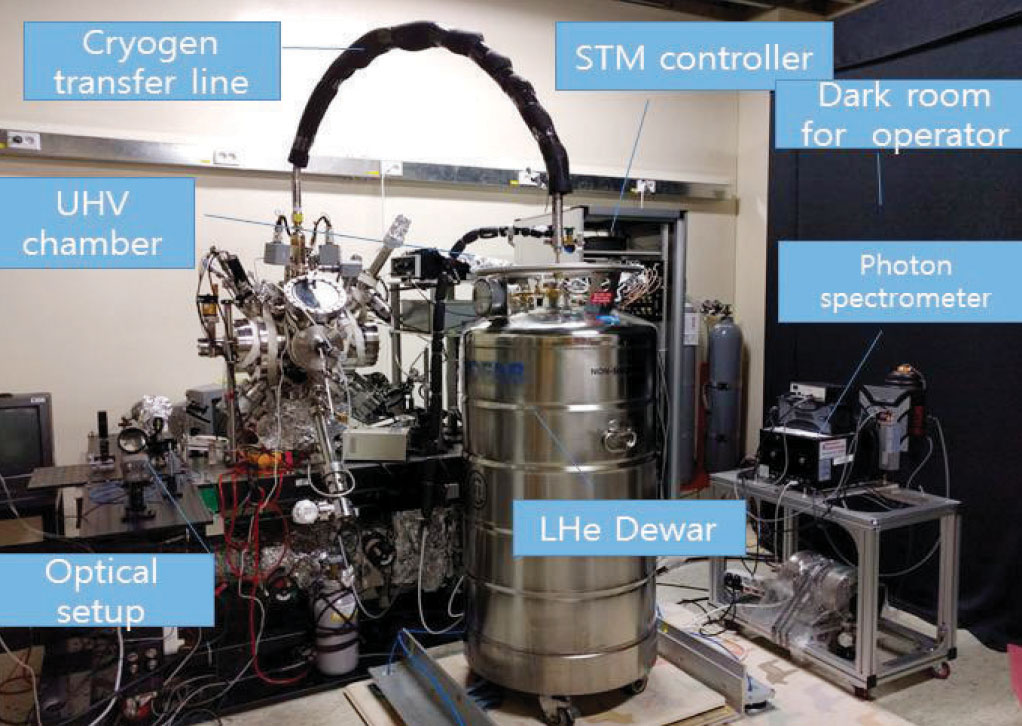
Figure 11. Overview of Photon STM
-
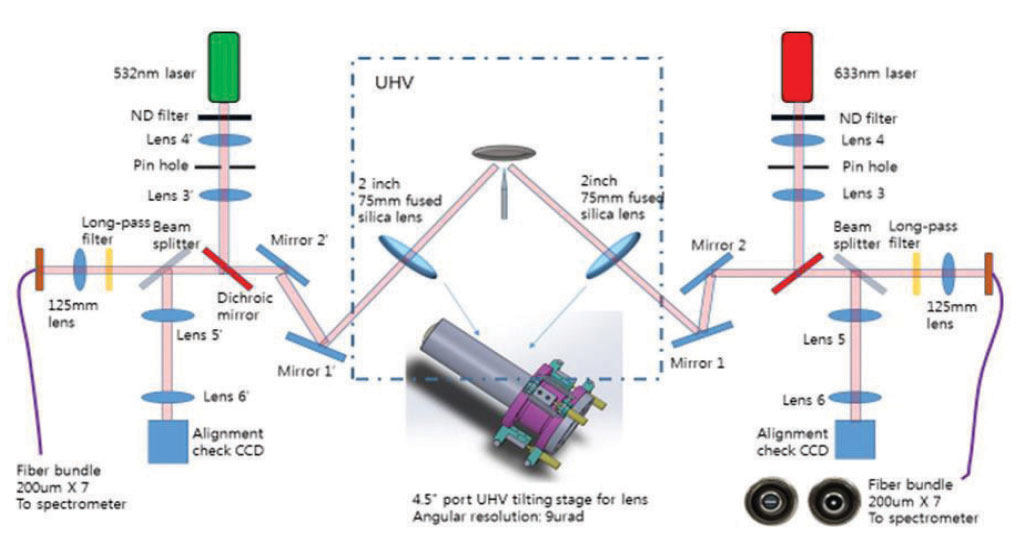
Figure 12. Optical Setup of Photon STM
In 2016, we have constructed a photon scanning tunneling microscope (Photon STM), which is capable of detecting photons coming from the STM junction (Fig. 11). Using a spectrometer and a CCD, this photon STM can analyze the photon energy spectrum in mainly visible light range. As shown in Fig. 12, the foci of the two convex lenses are located at the STM junction in the ultrahigh vacuum chamber, so that as many photons as possible can be measured. The sample temperature range of this Photon STM is ~ 8 Kelvin or higher. One of main operation schemes of Photon STM s is similar to inverse photoemission: tunnel electrons are injected to the sample with a spatial resolution of sub-angstrom, and photons are emitted. For example, with single molecules on a proper decoupling layer such as a-few-angstrom thick oxide layers on a metal substrate, photon spectra of sub-angstrom spatial resolution and sub-meV energy resolution can be measured.
극저온 고자기장 냉동기는 고자기장, 극저온의 환경하에서 시료의 전기적 특성을 측정하기 위한 환경을 조성하는 장치이다. 극저온, 고자기장의 극한환경에서의 전하수송 및 자성특성 측정을 통해 표면 또는 계면에 형성된 저차원 전하계에서 나타나는 양자진동, 양자홀 효과등을 관측함으로써 스핀이 분해된 전자구조와 전자/스핀 결합 유무, 전하계의 차원 등을 규명할 수 있다. 현재 해당 장비는 18T의 고자기장과 1.3 K의 저온환경은 상시적으로 가동되고 있으며, 최대 20T의 고자기장과 10 mK의 극저온 환경 조성테스트도 완료되었다. 현재 활용 가능한 측정 기법은 자기저항과 홀효과, 전압-전류 측정, 자기 토크 측정, 2 GPa 고압셀 사용, 1축 각도조절 물성 측정이며, 향후 다양한 측정기법과 장비가 추가될 예정이다.
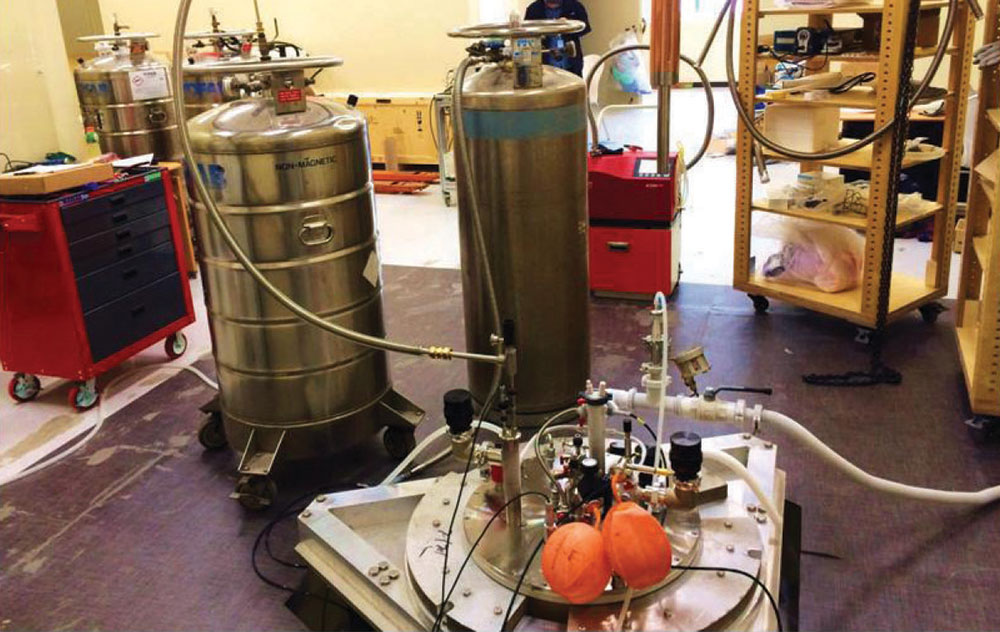
Figure 13. (left) high-magnetic-field/dilution-refrigerator and the measurements systems (right) the dilution-refrigerator part
A high-field-magnet/dilution-refrigerator system offer a unique environment of high magnetic field of 20 T and low temperature down to 10 mK. Under such extreme conditions, quantum transport properties, including quantum Hall effect and quantum oscillations, reveals the detailed information on electronic structures of the interfacial and/or surface electronic systems and their coupling to other internal degrees of freedom. Various types of measurements such as magnetoresistance, Hall effect, currentvoltage characteristics, torque magnetometry, and specific heat are regularly used at high fields up to 18 T and low temperatures down to 1.3 K. The test experiments at higher fields up to 20 T and lower temperatures down to 10 mK were successfully done. In addition, a piston-type high pressure cell with a maximum pressure of 2 GPa and an one-axis rotator probe are ready to be used.
포항공과대학교와 나노융합기술원의 지원으로 건축된 건물 안에 큰 관성질량을 가지는 무진동시스템을 구축하였다. 큰 관성질량과 능동형 제진대를 이용하여 외부진동을 효과적으로 차단하여, 진동에 민감한 고성능 연구 장비의 성능을 최적화할 수 있으며, 현재 3개의 무진동시스템이 설치되어 있다. 2017년 1월 현재, 고자기장극저온실험 장비가 무진동시스템에 장착되어 운용 중이며, 원자힘현미경이 현재 무진동시스템에 장착될 예정이다. 극저온고자기장 주사터널현미경은 핵심 장비인 극저온고자기장 냉동기가 배송되어 2017년 3월말 무진동시스템에 설치예정이다. 이로서 3개의 무진동시스템에 극저온 장비들이 모두 설치되어 2017년 하반기부터 본격적으로 운용될 계획이다. 현재 각종 유틸리티가 설치되었으며, 특히 2016년 여름동안 외부 소음을 효과적으로 차단할 수 있는 고기능성 흡음재를 이용한 방음공사를 진행하였다.
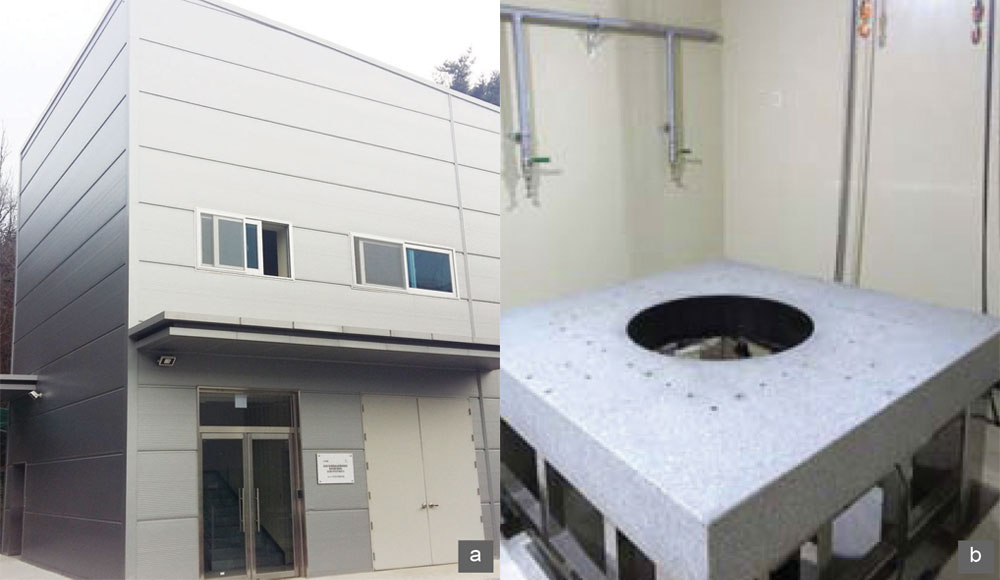
Figure 14. a. Building for low vibration laboratory
b. Vibration isolation table with active damping
We built an anti-vibration facility with support of POSTECH and NINT. The main feature is high inertia and active damping feedback system in order to isolate external vibrations from our flagship instruments. We installed three anti-vibration systems, where three low-temperature instruments with high magnetic field is or will be installed soon. Now various utilities are installed and ready for operation. Especially, we built sound-proof walls in order to reduce acoustic noise effectively.
 Center for Artificial Low
Center for Artificial Low